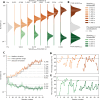A harbor seal (Phoca vitulina) shows extensive respiratory control in sound production
- PMID: 40890609
- PMCID: PMC12403956
- DOI: 10.1186/s12862-025-02404-9
A harbor seal (Phoca vitulina) shows extensive respiratory control in sound production
Abstract
The duration of animal vocalizations varies between and within species. Which mammals can learn to control this duration? Such respiratory production learning is a scarcely studied subcomponent of vocal learning. Here, we test the hypothesis that harbor seals (Phoca vitulina) are capable of respiratory production learning by testing whether a harbor seal can be trained to i) actively control its vocalization’s duration in two directions (short and long), and ii) exceed the pre-experimental vocalization’s duration (min = 0.202 s, max = 2.621 s). The seal learned to produce uninterrupted vocalizations spanning more than two orders of magnitude in duration, from 79 ms to 9.23 s. Our findings demonstrate a remarkable level of respiratory control in a harbor seal: this respiratory production learning encompasses an extensive range of sound durations and arises at a young age. Producing durations that span such a magnitude is hardly reported in the non-human animal literature; this capacity may be orthogonal to other vocal learning modules and should be tested in more species, both vocal production learners and non-learners.
Supplementary Information: The online version contains supplementary material available at 10.1186/s12862-025-02404-9.
Keywords: Animal training; Bioacoustics; Breathing control; Respiratory production learning; Vocal learning.
Conflict of interest statement
Declarations. Ethics approval and consent to participate: All training and testing were conducted according to the requirements of the Landesamt für Natur, Umwelt und Verbraucherschutz (LANUV) NRW, Germany, section animal experiment affairs. Upon detailed discussions with the LANUV, the need for approval was waived (file number Az.81–04.78). Informed consent was obtained from all owners of the animals used in the study. Consent for publication: Not applicable. Competing interests: The authors declare no competing interests.
Figures


Similar articles
-
Geographic variation and acoustic structure of the underwater vocalization of harbor seal (Phoca vitulina) in Norway, Sweden and Scotland.J Acoust Soc Am. 2004 Oct;116(4 Pt 1):2459-68. doi: 10.1121/1.1782933. J Acoust Soc Am. 2004. PMID: 15532676
-
Opportunistic detection of anthropogenic micro debris in harbor seal (Phoca vitulina vitulina) and gray seal (Halichoerus grypus atlantica) fecal samples from haul-outs in southeastern Massachusetts, USA.Mar Pollut Bull. 2019 Aug;145:390-395. doi: 10.1016/j.marpolbul.2019.06.020. Epub 2019 Jun 21. Mar Pollut Bull. 2019. PMID: 31590801
-
Congenital Diseases in Harbor Seals (Phoca vitulina richardsii) from the Salish Sea.J Wildl Dis. 2021 Jul 1;57(3):672-677. doi: 10.7589/JWD-D-20-00179. J Wildl Dis. 2021. PMID: 34015807
-
Vocal usage learning and vocal comprehension learning in harbor seals.BMC Neurosci. 2024 Oct 4;25(1):48. doi: 10.1186/s12868-024-00899-4. BMC Neurosci. 2024. PMID: 39367300 Free PMC article.
-
Underwater auditory localization by a swimming harbor seal (Phoca vitulina).J Acoust Soc Am. 2006 Sep;120(3):1550-7. doi: 10.1121/1.2221532. J Acoust Soc Am. 2006. PMID: 17004477
References
-
- Adams A, Vogl W, Dawson C, Raverty S, Haulena M, Skoretz SA. Laryngeal and soft palate valving in the harbour seal (Phoca vitulina). J Exp Biol. 2020;223(20):jeb230201. 10.1242/jeb.230201. - PubMed
-
- Baken RJ. Clinical measurement of speech and voice. London: Taylor & Francis Ltd; 1987.
-
- Blix AS. Adaptations to deep and prolonged diving in phocid seals. J Exp Biol. 2018;221(12):jeb182972. 10.1242/jeb.182972. - PubMed
-
- Boersma P, Weenink D. (2022). Praat: doing phonetics by computer In Glot International (Version 6.2.12) retrieved 17 April 2022 from http://www.praat.org/.
LinkOut - more resources
Full Text Sources
